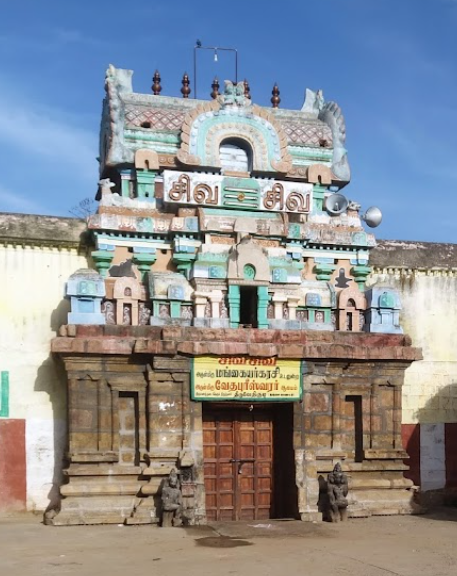A Chola king was deeply concerned about the delay in his daughter’s marriage. Seeking a solution, he visited the Vedapureeswarar Temple and worshipped Mother Mangayarkarasi, asking for her blessings for a timely wedding. Soon after, his daughter’s wedding took place, and as a token of gratitude, the king renamed her Mangayarkarasi. He also undertook numerous renovations to the temple to honor the goddess.
Sthala Puranam :
Before the great dissolution (pralayam), the demon Hayagriva stole the Vedas and concealed them beneath the ocean. To retrieve the Vedas, Lord Vishnu took the form of Hayagriva, a human with a horse’s face, and vanquished the demon. However, the Vedas felt tainted by their contact with Hayagriva, so they came to this temple to worship Lord Shiva to regain their purity. In some Puranas, the demons Madhu and Kaitabha are mentioned, with Lord Vishnu taking the Matsya avatar to defeat them. This part of the story is also connected to the Puranam of the Devanatha Perumal Temple at Thiruvaheendrapuram.
Brahma, known as “Vedi” because he is the guardian of the Vedas, worshipped Lord Shiva at this temple. This association contributed to the name Thiruvedhikudi and to the main deity being referred to as Vedapureeswarar. It is also believed that this area was once populated by Vedic Brahmins, who officiated at Nandi’s wedding.
Legend has it that the moolavar (main deity) was discovered in a marsh of plantain trees, which led to the earlier name, Vazhai Madu Nathar.
Saint Tirugnanasambandar had a vision of Lord Shiva's marriage to Parvati here, making the temple a prarthana sthalam (place of prayer) for those seeking marriage. In his pathigam, Sambandar emphasizes this significance. A related story recounts how a Chola king, facing challenges in marrying off his daughter, worshipped at this temple. Following his prayers, her marriage was successfully arranged, prompting the king to rename her Mangayarkarasi in honor of the goddess at the temple.
Historically, this place was referred to as Parakesari Chaturvedi Mangalam. The temple's core structure dates back to the late 9th and early 10th centuries during the reign of Aditya Chola I, with subsequent additions from later Chola dynasties and the Thanjavur Nayaks and Marathas, all of which are noted in the temple's inscriptions. The second prakaram (corridor) surrounding the garbhagriha was constructed by the Vijayanagara dynasty.
In a unique iconographic representation, Ardhanareeswarar is depicted with Parvati on the Lord’s right side, similar to the portrayal at the Kalyana Sundareswarar Temple in Velvikudi. The four Vedas are symbolized by four Nandis positioned on the outer wall of the temple and on the vimanam (tower) above the garbhagriha, facing the four cardinal directions. Additionally, Lord Vinayakar in the maha mandapam is depicted with his head tilted to one side, as if attentively listening to a rendition of the Vedas, earning him the name Veda Vinayakar.
Administration History :
The administration of Vedapureeswarar Temple in Thiruvedhikudi is documented through inscriptions from the Chola period, particularly during the reigns of Aditha Chola I, Koparakesari Varman, and Rajaraja I. These inscriptions detail endowments for temple upkeep, rituals, and services, including contributions of land, gold, cattle, and manpower for maintaining lamps, poojas, and festivals. Later, Vijayanagara rulers and Thanjavur Nayaks also contributed to the temple's development and maintenance.
